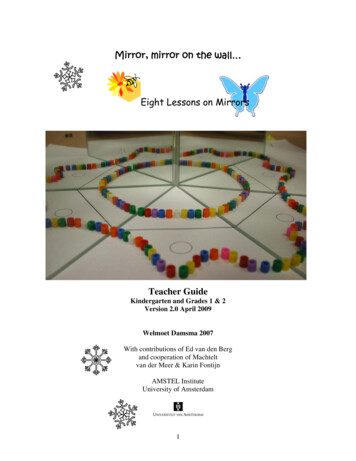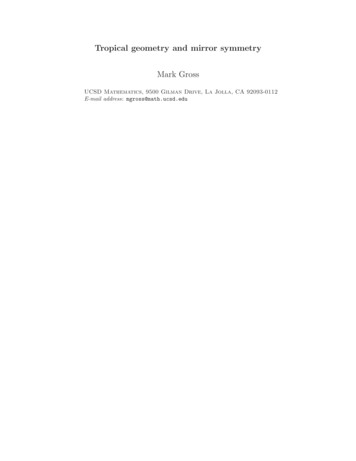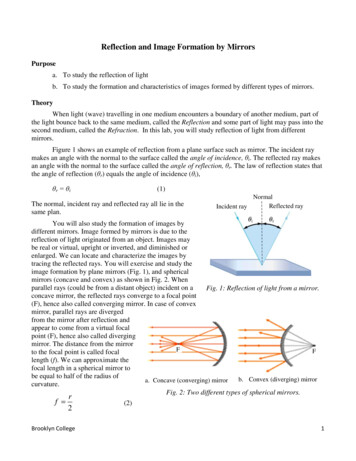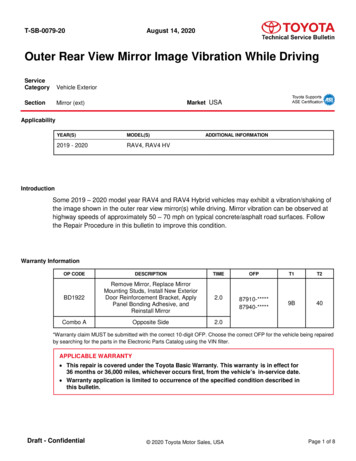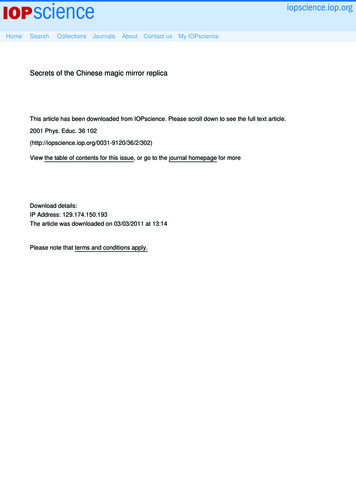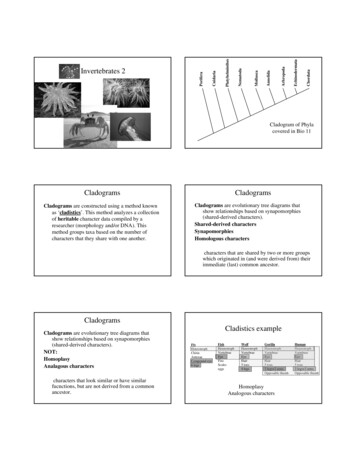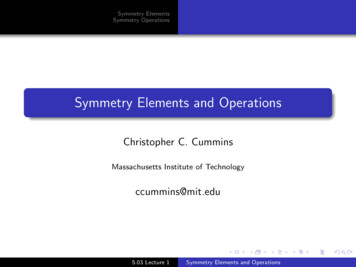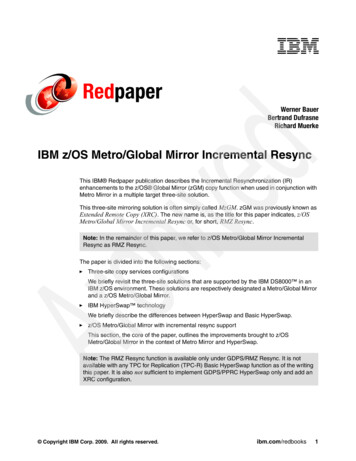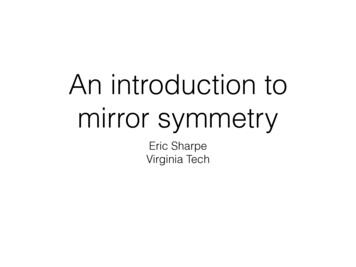
Transcription
An introduction tomirror symmetryEric SharpeVirginia Tech
This will be a talk about string theory,so let me discuss the motivation .Twentieth-century physics saw two foundational advances:General relativity!(special relativity)Quantum field theory!(quantum mechanics)Problem: They contradict each other!Something else is needed .
String theory is a physical theory thatreconciles GR & QFT,by replacing elementaryparticles by strings.
We fatten Feynman diagrams,which removes QFT-like divergences.In QFT, those divergences implyscale-dependence of physics.Do not expect such scale-dependence from a fundamentaltheory, hence no divergences is good.
10-33 cmThe typical sizes of the strings are very small — of order thePlanck length. To everyday observers, the string appears tobe a pointlike object.
From dim’l analysis, typical energy scale for strings isPlanck energy ( h c5 / G )1/2 1019 GeVHow big is that?1 GeVProtonmass;alsoQCDscale10 4 GeV 10 TeVWmassLHC@CERN1 Joule10 10 GeV10 15 GeVHighest energycosmic raysever observedGUTscaleRest energy ofa bacterium10 20 GeVPlanckscale;alsorest energyof grainof sand
Perturbative (critical) string theory is consistent in 10dimensions.Yet, the real world is 4 dimensional(3 space, 1 time).So, how can string theory describe the real world?
Compactification scenarioAssume 10d spacetime R4 x M,where M is some (small) (compact) 6d space.So long as you work at wavelengths much larger than the sizeof the compact space, you can’t see the extra dimensions;spacetime looks like R4.
Kaluza-Klein theoryThis picture of compactifying extra dimensions and gettingextra fields in the 4d theory was historically first invented byKaluza and Klein back in the 1920s.They proposed a unification of gravity and electromagnetism,viewed as pure gravity in 5d, on R4 x S1.(5)gmn5d metric (4)gµ A 4d metricU(1) gauge fieldAµscalar fieldString compactifications are a natural generalization.
What sort of 6-dim’l space can you compactify on? Needs to satisfy Einstein’s equations for general relativity invacuum To get a supersymmetric’ low-energy four-dim’l effectivetheory, need some add’l propertiesResult, in simplest cases, is that it must be Ricci-flatplus a few other things;known as a “Calabi-Yau” manifold
What’s a Calabi-Yau ?Technically: complex Kahler manifold with trivial canonicalbundle a space that (among other things) satisfies Einstein’sequations for a vacuum (meaning, it’s Ricci-flat).Example: T2But that’s pretty boring;more complicated examples also exist, in higher dimensions.
What difference can this make?If that 6d space is too small to be observed,what impact can it have on observable 4d physics?
Although you can’t see the internal 6d space directly,the geometry of that space determines properties of thelow-energy 4d theory.Example: How to count massless spinors in 4dRecall Dirac equ’n for spinors of mass m:/(iDm) 0/ 10Start with 10d massless spinors: D 0We can decompose the 10d Dirac operator into/ 10 D/6 D/4Dand so we get 4d massless fermions from sol’ns of/6D 0
/6The solutions of D 0(which determine 4d massless fermions)can be characterized in terms of mathematical invariants ofthe 6-dim’l space, known as cohomology groups’’For example, on a Calabi-Yau, there are numbershp,q dim’s of certain (Dolbeault) cohomology groups.Math: these are groups of closed complex differential forms!a1 ···ap a1 ···aq dz a1 · · · dz ap dz a1 · · · dz aq(mod exact).In compactifications of type II strings,these count 4d fermions with charges p, qunder a pair of U(1) symmetries.
More generally, not just the number of particles but also theircouplings, etc, are determined by the geometry of the internal6d space.In short, learn about 4d physics by studyingmathematical structure of the 6-manifold.
I’ve just told you why math is interesting to physicists,but the reverse has also turned out to be true:Thinking about the resulting physics has led to newmathematics, which is what I’ll outline today.
Outline Overview of mirror symmetry and curve-counting Heterotic generalizations: (0,2) mirror symmetry quantum sheaf cohomology
Mirror symmetry a duality between 2d QFT’s,first worked out in early 1990sPairs of (usually topologically distinct)Calabi-Yau manifolds are described bysame string theory — strings cannot distinguish.
Mirror symmetryWhen two Calabi-Yau manifolds M, W are mirror,they turn out to be very closely related(but usually topologically distinct).Example: dim M dim WAfter all, if strings are unable to distinguish one from the other,then the compactified theory should be the same— in particular, the dimension of the compactified theory hadbetter not change.
Mirror symmetrySince the spectrum of light four-dimensional particlesis determined by (Dolbeault) cohomology,we can conclude that dim H*,*(M) dim H*,*(W)— total number of 4d particles should be unchanged.
Mirror symmetryCalabi-Yau spaces are (incompletely) characterized byhp,q’s ( dim’s of Dolbeault cohomology groups),which compute the number of massless particles.For example, for a 4-dim’l space, these ”h2,2Mirror symmetry acts as a rotation about the diagonal:if X is mirror to Y, then hp,q (X) hn p,q (Y ).
Example: T2T2 is self-mirror topologically. Diamond’ of hp,q’s:— symmetric under rotationThis symmetry isspecific to 2d manifoldswith 1 handle;for g handles:1gg1
Example: Quartics in P3(known as K3 manifolds)K3 is self-mirror topologically;complex, Kahler structures interchangedh1,1h1,1Hodge diamond:Kummer surface22(x y z22 2aw ) 3a 13 app w z p2xq w z p 2xt w z p2ys w z2ya 1.5w 1 pqts 0
Example: QuinticThe “quintic” (deg 5 hypersurface in P4 ) is a nontrivialCalabi-Yau 6-manifold.QuinticMirror
Mirror symmetry between spaces MW exchanges:classical computations on M(perturbative in 2d QFT)(Feynman diagrams)sums over minimal area (2d) surfaces on W(nonperturbative in 2d QFT)(2d instantons)The fact that this duality exchanges (easy) perturbative effects& (hard) nonperturbative effectsmakes it very useful for computations!
Degree kn1287526092503317206375Shown: numbers of minimal area S2’s in one particularCalabi-Yau (the “quintic”), of fixed degree.These three degrees were the state-of-the-art in mathematicsbefore mirror symmetry(deg’ 2 in ’86, deg’ 3 in ’91)Then, b/c of physics, mirror symmetry ’92 .
Degree 4288164978454686113488249750 This launched an army of algebraic geometers .
In math, these surface counts form ‘Gromov-Witten’ theory.Physically, these numbers, these surface counts, arecomputing stringy nonperturbative corrections to Yukawacouplings in 4d theories with nonminimal (N 2)supersymmetry.It would be more useful to compute the analogues in 4dtheories with minimal (N 1) supersymmetry.(Or, even better, no supersymmetry at all, but usually we thinkof getting N 1 at Planck scale, then breaking supersymmetrydynamically.)We’ll see such an analogue shortly.First, how many mirrors are there? How are they built?
Numerical checks of mirror symmetryPlotted below are data for a large number ofCalabi-Yau manifolds.Vertical axis: h1,1 h2,1Horizontal axis: 2(h1,1 - h2,1) 2 (# Kahler - # cpx def’s)Mirror symmetryexchanges h1,1h2,1 symm’ across vert’ axis(Klemm, Schimmrigk, NPB 411 (’94) 559-583)
Constructions of mirror pairsOne of the original methods:in special cases, can quotient by a symmetry group.“Greene-Plesser orbifold construction”(Greene-Plesser ’90)Example: quinticQ5 P4mirror3 Q/Z55More general methods exist .
Constructions of mirror pairsBatyrev’s construction:For a hypersurface in a toric variety,mirror symmetry exchangespolytope ofambienttoric varietydual polytopefor ambient t.v.of mirror
Constructions of mirror pairsExample of Batyrev’s construction:T2as degree 3 hypersurface in P2 P2 /Z32P P 0 {y hx, yi1 8x 2 P }Result:degree 3 hypersurface in P2,mirror toZ3 quotient of degree 3 hypersurface(matching Greene-Plesser ’90)
Ordinary mirror symmetry is pretty well understood nowadays. lots of constructions both physics and math proofsGivental / Yau et al in mathMorrison-Plesser / Hori-Vafa in physicsHowever, there are some extensions of mirror symmetry thatare still being actively studied.One example: heterotic mirror symmetryPertinent for 4d theories with minimal (N 1) supersymmetry
Heterotic mirror symmetryis a conjectured generalization involving heterotic’ strings.Ordinary mirror symmetry involves type II’ stringswhich are specified by space metric in 10d.Heterotic strings are specified byspace metric nonabelian gauge field in 10d.Thus, heterotic mirror symmetry involves not just spaces,but also nonabelian gauge fields (bundles).
Heterotic mirror symmetryis a generalization that exchanges pairs(X1 , E1 )(X2 , E2 )where the Xi are Calabi-Yau manifoldsand the Ei are bundles / nonabelian gauge fields over Xi .Constraints: for each E, X,[tr F F ] [tr R R] d(· · · )equivalently: ch2 (E) ch2 (T X)If nonabelian gauge field spinor connection,then F R (E T X) & so satisfied trivially.
Heterotic mirror symmetryThe (2d) quantum field theories defining heterotic strings,include those of other (“type II”) string theoriesas special cases.Hence, heterotic mirror symmetry ought to reduceto ordinary mirror symmetry in a special case,& that turns out to be when Ei T Xi (Fi Ri ) .
Heterotic mirror symmetryMuch as in ordinary mirror symmetry,dimensions and ranks are closely constrained:If (X1 , E1 ) is mirror to (X2 , E2 ) ,thendim X1 dim X2rank E1 rank E2
Heterotic mirror symmetryHere, massless particles are computed byqp different cohomology groups: H (X, E ) .Heterotic mirror symmetry exchangesHqp (X1 , E1 ) Hqr p (X2 , E2 )just as ordinary mirror symmetry exchangesH p,q (X1 ) H np,qp,q(X2 )qp When E T X, H (X) H (X, E )& so we see ordinary mirrors as special cases.
Heterotic mirror symmetryNot as much is known about the heterotic version,though a few basics have been worked out.Example: numericalevidence1h(E)Horizontal:Vertical:h1 (E )h1 (E) h1 (E )where E is rk 4(Blumenhagen, Schimmrigk, Wisskirchen,NPB 486 (’97) 598-628)
Heterotic mirror symmetryConstructions include: extended Greene-Plesser orbifoldconstruction to (0,2) models — handy but only gives specialcases Adams-Basu-Sethi ’03 Melnikov-Plesser ’10Blumenhagen-Sethi ’96repeated Hori-Vafa-Morrison-Plesser-style GLSMduality in (0,2)extended Batyrev’s construction & monomialdivisor mirror map to include def’s of tangent bundle, forspecial (‘reflexively plain‘) polytopesProgress, but still don’t have a general construction.
Heterotic mirror symmetryCounting minimal area surfaces playeda crucial role in the original mirror symmetry,and also arises in the heterotic version.In the heterotic version, it’s more complicated(count minimal area surfaces take into account thenonabelian gauge field).Heterotic version first worked out byS. Katz, ES in 2004,& there’s been lots of work since then.(Adams, Anderson, Aspinwall, Distler, Donagi, Ernebjerg, Gray, Lapan, McOrist, Melnikov, Plesser, Quigley,Rahn, Sethi, .)
Minimal area surfaces:!standard case (“type II strings”)Schematically: For X a space,M the space of minimal area S2’s in Xwe compute a “correlationfunction”ZhO1 · · · Ok i MZM!1 · · · !kpi ,qiO !2H(M)where ii(top form on M)which encodes minimal area surface information.Such computations are at the heart of Gromov-Witten’ theoryin the math community.
Minimal area surfaces:!heterotic caseSchematically: For X a space, E a bundle on X,M the space of minimal area S2’s in XZhO1 · · · Ok i ! 1 · · · ! kMqipi i 2 H (X, F )where Oi !F bundle of 2d fermi zero modes over MGRRanomaly cancellation ) top F KM Zhence, again,M(top form on M)(S Katz, ES, 2004)
Correlation functions are often usefully encoded in operator products’ (OPE’s).Physics: Say OA OB XiOi(“operator product”)if all correlation functions preserved:XhOA OB OC · · · i hOi OC · · · iiMath: if interpret correlation functions as maps Sym W! C(where W is the space of O ’s)then OPE’s are the kernel, of form OA OBXiOi
Examples:Ordinary (“type II”) case:X P1 P1OPE’s:where22W H 1,1 (P1 P1 ) C C{ , } q, 2 q̃q, q̃ exp( area)! 0 in classical limitLooks like a deformation of cohomology ring,so called “quantum cohomology”
Examples:Ordinary (“type II”) case: X P1 P122 q, q̃OPE’s:Heterotic case:1111T(P P)E a deformation ofX P PDef’n of E :0where ! W OAxC x̃BxDx̃ ! O(1, 0)2O(0, 1)2! E! 0A, B, C, D const’ 2x2 matricesx, x̃ vectors of homog’ coord’s1 2 }W H(X,E) C C{,Here, OPE’s: det A B q, det C D q̃Check: E T X when A D I2 2 , B C 0& in this limit, OPE’s reduce to those of ordinary case“quantum sheaf cohomology”
Review of quantum sheaf cohomologyTo make this more clear, let’s work through the details:Example: classical sheaf cohomology on P1 P1with gauge bundle E a deformation of the tangent bundle:*0 W O O(1,0) O(0,1) E 0!###"### *where Ax* Cx!22Z*Bx Dx! 1!Px, x homog’ coord’s on ‘sand W !2Operators counted by H (E ) H (W O) W1*n-pt correlation function is a map0Sym n H1 (E * ) Sym n W H n ( n E * )OPE’s kernelPlan: study map corresponding to classical corr’ f’n
Review of quantum sheaf cohomologyExample: classical sheaf cohomology on P1 P1with gauge bundle E a deformation of the tangent bundle:*0 W O O(1,0) O(0,1) E 0!###"### *where Ax* Cx!Bx Dx! 22Z*1!Px, x homog’ coord’s on ‘sand W !2Since this is a rk 2 bundle, classical sheaf cohomology1*0H(E) H(W O) W.defined by products of 2 elements of0222 *H(SymW O) H( E ) corr’ f’nSo, we want to study mapThis map is encoded in the resolution0 E Z Z W Sym W O 02*22
Review of quantum sheaf cohomologyExample: classical sheaf cohomology on P1 P10 E Z Z W Sym W O 02*22Break into short exact sequences:0 E Z S1 02*20 S1 Z W Sym W O 02Examine second sequence:δinduces H (Z W ) H (Sym W O) H (S1 ) H (Z W )00Since Z is a sum of O(-1,0)’s, O(0,-1)’s,0021 1hence δ : H (Sym W O) H (S1 )021is an iso.Next, consider the other short exact sequence at top .
Review of quantum sheaf cohomologyExample: classical sheaf cohomology on P1 P10 E Z Z W Sym W O 02*22Break into short exact sequences:0 S1 Z W Sym W O 02 δ : H (Sym W O) H (S1 )Examine other sequence:0210 E Z S1 02*2δinduces H ( Z ) H (S1 ) H 2 ( 2 E * ) H 2 ( 2 Z )0Since Z is a sum of O(-1,0)’s, O(0,-1)’s,1H ( Z ) 02221butH ( Z ) ! !12122 *δ:H(S) H( E )and so1has a 2d kernel.Now, assemble the coboundary maps .
Review of quantum sheaf cohomologyExample: classical sheaf cohomology on P1 P10 E Z Z W Sym W O 02*22Now, assemble the coboundary maps .A classical (2-pt) correlation function is computed as 22 *1 H( E)H 0 (Sym 2W O) H(S)1δδwhere the right map has a 2d kernel, which one can show isgenerated bydet(Aψ Bψ! ), det(Cψ Dψ! )where A, B, C, D are four matrices defining the def’ E,and ψ ,ψ! correspond to elements of a basis for W.Classical sheaf cohomology ring:![ψ ,ψ" ] / ( det(Aψ Bψ" ),det(Cψ Dψ" ))
Review of quantum sheaf cohomologyQuantum sheaf cohomology OPE ring of the A/2 modelInstanton sectors have the same form,except X replaced by moduli space M of instantons,E replaced by induced sheaf F over moduli space M.Must compactify M,and extend F over compactification divisor. E KXch 2 (E) ch 2 (TX)top*}GRR F KMtop*Within any one sector, can follow the same method justoutlined .
Review of quantum sheaf cohomologyIn the case of our example,one can show that in a sector of instanton degree (a,b),the classical’ ring in that sector is of the formb 1!Sym W/ (Q , Q ) wherea 1Q det(Aψ Bψ! ) , Q! det(Cψ Dψ! )Now, OPE’s can relate correlation functions in differentinstanton degrees, and so, should map ideals to ideals.To be compatible with those ideals,〈O〉 a,b qa ′ afor some constants q, q!q!b ′ b〈OQa ′ ab ′ b!Q 〉 a′ ,b′ OPE’s Q q, Q! q!— quantum sheaf cohomology rel’ns
Current state of the art:For spaces called toric varieties,’and deformations of the tangent bundle,heterotic curve corrections encoded in an OPE ring of formY(det M )Qa qa (McOrist-Melnikov ’07-’08 using GLSM effective actions to give results for linear’ deformations;Donagi-Guffin-Katz-ES 2011 using mathematical computations valid for all deformations)
Long-termMore general constructions of (0,2) mirrors,as current methods are limitedGeneralize quantum sheaf cohomology computations toarbitrary compact Calabi-Yau manifolds
Generalize quantum sheaf cohomology computations toarbitrary compact Calabi-Yau manifoldsTo get there, we’re currently looking at computations fordeformations of tangent bundles of Grassmannians. Has some of the technical complexities expected for generalcase (induced sheaves not locally free, for example) But hopefully enough symmetry to guide to a solution.
Summary Overview of mirror symmetry and curve-counting Heterotic generalizations: (0,2) mirror symmetry quantum sheaf cohomology
Thomasquantum d theoriesHomotopy, categories:derived categoriesD-branesstacksgauge theoriesderived spacessigma models w/ potentialcategorical equivalencerenormalization group flow
Ordinary mirror symmetry is pretty well understood nowadays. lots of constructions both physics and math proofs However, there are some extensions of mirror symmetry that are still being actively studied. One example: heterotic mirror symmetry Pertinent for 4d theories with minimal (N 1) supersymmetry Givental / Yau et al in math
